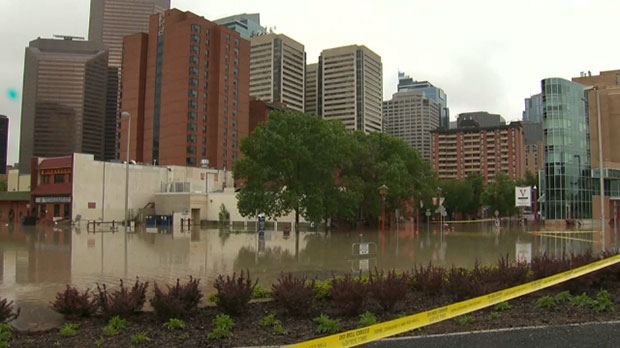Snowpack may be high west of Calgary, but flooding depends on rainfall

Snowpack in the mountains west of Calgary is above average this year, but that doesn't mean the risk of flooding is also higher than normal.
The real risk of flooding, officials say, depends on how much rain falls in the area over the next two months.
"Heavy rainfalls west of Calgary are more so the trigger for river flooding," said Sandy Davis, team lead of river engineering.
"Over the next couple of months, we’ll be monitoring the rivers 24/7, keeping an eye on any large rain systems that can cause river flooding, while closely watching the snowpack in the mountains as it starts to melt."
To prepare for spring runoff, water levels in the Glenmore Reservoir and Ghost Reservoir have been lowered to create more room for potential flood water.
Crews are also testing infrastructure like river outfalls and lift stations, while also stockpiling materials for temporary barriers.
"In addition to seasonal preparations, in nearly 10 years since the 2013 flood, Calgary is in a better position to be protected from flooding thanks to significant infrastructure investments, reducing Calgary’s flood risk by 55 per cent and potential flood damages by $90 million every year," the city said in a release.
"This year, the downtown flood barrier is in place, creating a continuous flood barrier from the Peace Bridge to the Reconciliation Bridge, helping protect the safety of Calgarians and critical infrastructure in Downtown, Chinatown, East Village and Eau Claire communities. Construction has also begun on the Springbank Off-Stream Reservoir (SR1) west of the city."
Flood season in Calgary runs from May 15 to July 15 each year. A once-in-a-century flood event in 2013 caused an estimated $5 billion in damage.
"Once complete, SR1 is a complete game changer for Calgary, protecting thousands of residents that live and work along the Elbow River and downtown Calgary from a 2013-size flood," said Davis.
"Working with the higher gates at the Glenmore Dam, this infrastructure will reduce damages by over $3 billion through the next century, safeguard Calgary’s downtown, the region’s economic engine, protect critical public infrastructure like roads and CTrain lines and vital services like our drinking water and wastewater treatment plants that we all depend on."
The province is assessing three potential sites for a new reservoir on the Bow River, with a recommendation expected in 2023.
The city is also reminding Calgarians to be cautious around riverbanks at this time of year as they can become unstable.
More information on river conditions and flood risk is available on the city's website.
CTVNews.ca Top Stories

Bird flu, measles top 2025 concerns for Canada's chief public health officer
As we enter 2025, Dr. Theresa Tam has her eye on H5N1 bird flu, an emerging virus that had its first human case in Canada this year.
Azerbaijan observes day of mourning for air crash victims as speculation mount about its cause
Azerbaijan on Thursday observed a nationwide day of mourning for the victims of the plane crash that killed 38 people and left all 29 survivors injured as speculation mounted about a possible cause of the disaster that remained unknown.
Donald Trump says he urged Wayne Gretzky to run for prime minister in Christmas visit
U.S. president-elect Donald Trump says he told Canadian hockey legend Wayne Gretzky he should run for prime minister during a Christmas visit but adds that the athlete declined interest in politics.
Thousands without power on Christmas as winds, rain continue in B.C. coastal areas
Thousands of people in British Columbia are without power on Christmas Day as ongoing rainfall and strong winds collapse power lines, disrupt travel and toss around holiday decorations.
Prayers and tears mark 20 years since the Indian Ocean tsunami that killed some 230,000 people
People gathered in prayer and visited mass graves in Indonesia’s Aceh province on Thursday to mark 20 years since the massive Indian Ocean tsunami hit the region in one of modern history’s worst natural disasters.
New York taxi driver hits 6 pedestrians, 3 taken to hospital, police say
A taxicab hit six pedestrians in midtown Manhattan on Wednesday, police said, with three people — including a 9-year-old boy — transported to hospitals for their injuries.
Historical mysteries solved by science in 2024
This year, scientists were able to pull back the curtain on mysteries surrounding figures across history, both known and unknown, to reveal more about their unique stories.
Ho! Ho! HOLY that's cold! Montreal boogie boarder in Santa suit hits St. Lawrence waters
Montreal body surfer Carlos Hebert-Plante boogie boards all year round, and donned a Santa Claus suit to hit the water on Christmas Day in -14 degree Celsius weather.
Canadian activist accuses Hong Kong of meddling, but is proud of reward for arrest
A Vancouver-based activist is accusing Hong Kong authorities of meddling in Canada’s internal affairs after police in the Chinese territory issued a warrant for his arrest.































